Hello, My Name is Cuterebra emasculator (a.k.a. Bot Fly)
Yesterday I heard a pitiful screeching outside the window. Cristina and I both looked up from our computers with the same wide-eyed look and rushed out the door to see what was happening. Our local feral cat Bobtail had caught a squirrel and was carrying the poor screaming creature away by the neck. Hoping that the squirrel might not yet have been injured, I scared Bobtail off his prey. He dropped the squirrel which then convulsed, rolled over and abruptly died. It was a shocking and terrible sight.
But I would soon witness something far more horrifying. I didn’t know it yet, but I was about to come face to face with a Cuterebra larva, which you might know as a bot fly.
We examined the squirrel to search for wounds and discovered some disgusting volcanoes of flesh sticking up in three different places.
At first we assumed they were punctures from the attack but then one of the mounds began to open and writhe and wiggle.
“Oh my god. There’s something in there.”
We poked at it with a stick in slack-jawed horror as a nauseating goo dribbled out of the opening, like a giant pimple leaking diarrhea pus. (Too graphic? It gets worse.)
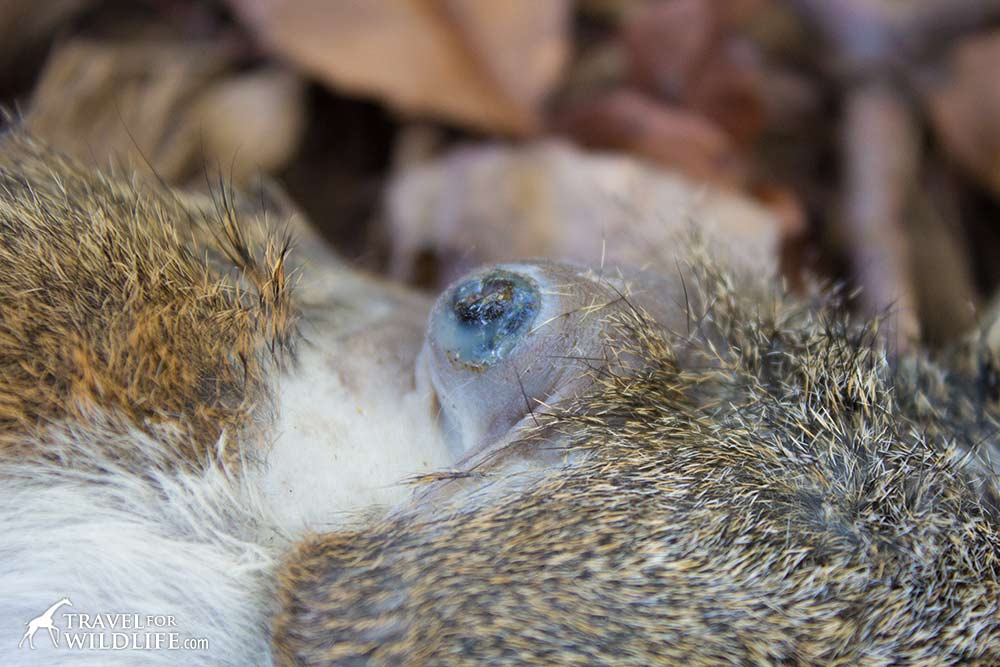
The bulge continued to undulate and squirm until a scaly dark brown shape began to force itself out of the orifice, like an alien bursting from the chest of its human host. This could only be one thing, a huge bot fly maggot coming out of a warble hole.
I have a deep respect for all living things. I believe all creatures have equal value and a right to exist. But… but…. This. This was an abomination so foul and perfect that I simultaneously fell in love with it and wanted to smash it into oblivion with a large rock. I got a severe case of the willies. Goose bumps stood up on my arms and my knees turned to jelly.
Cristina and I stared in stunned fascination as the throbbing mass worked its way out of the squirrel’s flesh, as if the soft white belly fur was giving birth to a horrible reptilian monster baby. But there was no head or face to be seen. That’s because the little fiend was being born ass first.
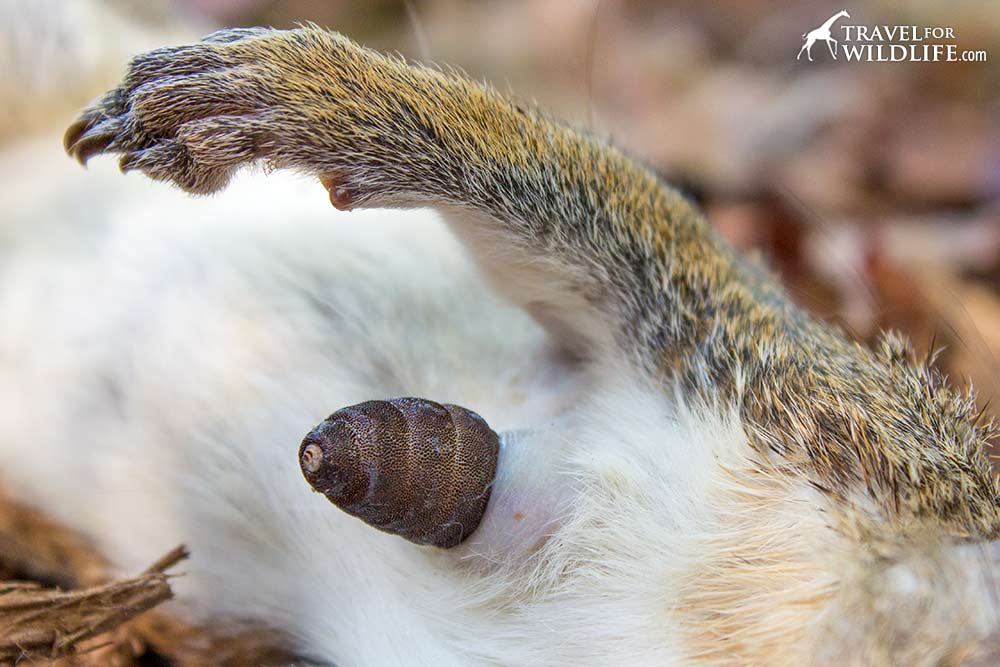
10 Facts about the Tree Squirrel Bot Fly (Cuterebra emasculator Fitch)
1) Bot Flies Are In Your Yard Right Now
I had heard vague references to botflies before, watched a few gross videos of bot fly larvae emerging from human heads, got thoroughly creeped out, and forgot about it. I always thought it was something that happened somewhere else. In fact botflies are an American phenomenon and many species of bot fly live right here in the United States.
The one I just met here in my yard in North Carolina was the Tree Squirrel Bot Fly (Cuterebra emasculator Fitch). This botfly larva may be encountered throughout the eastern United States. Other bot fly species living in the U.S. include the Horse Bot Fly (Gasterophilus intestinalis), the Caribou Botfly (aka Nose Bot) in Alaska (Hypoderma ttarandi), and the Mouse Bot Fly (Cuterebra fontinella).
In fact there are 30 different species of Cuterebra (rodent bot flies) in the United States. Even the Human Botfly (Dermatobia hominis) lives right next door in southern Mexico and may be encountered throughout much of Central and South America down to northern Argentina and Chile. Maybe you’ll bring one home from your next vacation!?
While there are similar species living in tropical Africa (like the Tumbu Fly Cordylobia anthropophaga), botflies are something that happens here. If you happen to be a tree squirrel get ready to be terrified.
2) Cuterebra Larva Come in Through Your Butt
Or your mouth. Or your nose. Or an open wound. The point is, a Cuterebra larva needs an opening to get inside its mammalian host. Adult tree squirrel bot flies lay eggs on branches and twigs that squirrels frequent. The first instar (when a larva molts into a larger size) occurs inside of the tiny white eggs that look like grains of rice. Here they wait for a mammal to come into contact with them. Triggered by heat or carbon dioxide, the tiny larvae emerge from a trap door in the egg and attempt to attach themselves to a passing mammal.
These maggots (called “bots” in a botfly) then look for an opening. Rather than burrow directly into the skin like any decent parasite would do, they instead travel over the body looking for an orifice to enter. The butt-hole usually works nicely. Maybe your mouth.
Ready for more delightful botfly facts?
3) They Burrow Through Your Body and Out to Your Skin
After entering the body of a host squirrel or chipmunk, the bot begins a magical one-week journey wandering through your guts until he finally comes to rest beneath the skin. Dear God! Here he molts to the second instar and prepares for the next amazing chapter of his life. He is now cream-colored with little bands of black spikes circling his body that help to hold him in place.
4) They Poop Out of a Hole in Your Skin
The next order of business is constructing a hole in the skin to poop out of. Why didn’t he just make a hole through the skin in which to enter in the first place? Because that just wouldn’t be gross enough. The Cuterebra larva anchors his head toward the host’s body and lines up its butt with the new hole so it can excrete liquid excrement. Yum! The host squirrel’s skin reacts by forming a nice little cozy pocket around the Cuterebra larva called a “warble”. The opening created at the top of this flesh volcano is called the warble pore.
5) They Breathe Through Their Butts
There’s another use for that fashionable new hole in your skin. The Cuterebra larva also has two breathing holes in his butt called “spiracles” and it needs the warble pore to breathe air through. Like most maggots he will spend this wonderful stage of life with his face buried in his food, and must breathe through his rear end. After about a week of this fun he will molt again into the third and final instar.
6) They Eat Pus
Oh, by the way. The Cuterebra larva is not eating your blood like most vertebrate parasites. This little champ is eating your pus (leukocytes and other dead cells) and lymph fluid. He spends a total of about three or four weeks feasting and leaking icky poop fluids out of his rear end. During this time his creamy white skin transforms to a dark scaly brown.
7) The Emasculator Will Eat Your Testicles?
The species Cuterebra emasculator Fitch was named more than a century and a half ago by a famous entomologist named Asa Fitch. The scientific name “emasculator” was chosen based on the belief that the parasite consumed the testes of male hosts. Thankfully, this horrifying fact turned out to be false.
According to an excellent article on the University of Florida website, “a male host’s testes may be temporarily prevented from descending into the scrotum or displaced back into the abdomen by the presence of a larva”, especially in chipmunks. Apparently that’s what led them to believe this little beast was a testicle muncher.
I have to admit, I did feel a bit emasculated as I stood petrified with horror staring at this little bug.
8) The Cuterebra Larva Really Doesn’t Want You to Die
Botflies don’t want to kill you or even harm you. On the contrary, these little guys need their hosts to stay happy and healthy in order to survive. Botfly warbles rarely get infected because if the host dies, so does the parasite. Which is why the fully-developed Cuterebra larva living on my poor dead squirrel friend decided to abandon ship. The 24-hour buffet had officially closed.
Healthy adult squirrels can have four or five warbles at a time without showing any ill effects, except itchiness. After a bot fly larva emerges from the skin, a warble hole usually heals up in a week or so. However, pregnant females, nursing mothers, or infants may show more serious negative side effects. Also, adult squirrels with higher levels of infestation or less-than-optimal health may experience anemia and become more prone to predation (as demonstrated in my yard).
9) They Wiggle Out of Your Skin Butt-First
Now that our little squirming friends have spent summer vacation dining on the bodily fluids of squirrels, it’s time to settle down for a long winter nap. Once he’s fully developed, the Cuterebra larva will begin writhing and undulating his way backwards out of the hole in your skin. If you can imagine anything more disgusting than this then you have a really horrifying imagination and you should stop imagining things right now. (If you can’t imagine it, watch the video at the end of this post.)
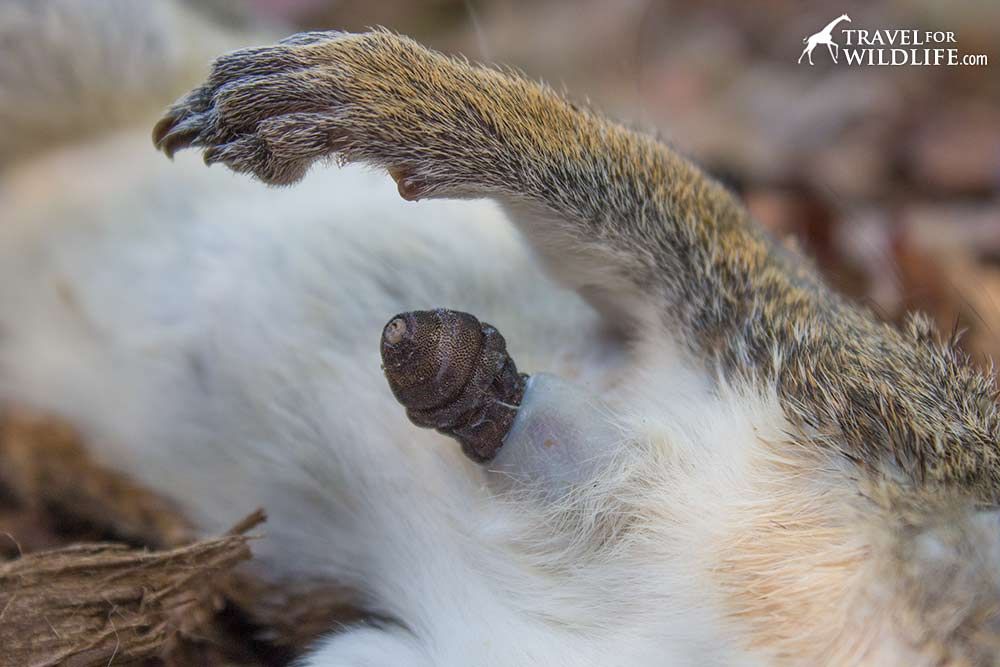
10) A Balloon Pops Out of Their Head. Surprise!
When the larvae emerges from the host’s skin, it drops to the ground and burrows into the soil to overwinter for 8 to 10 months and pupate. The larva forms a hard casing around itself called a “puparium” inside which it performs its final metamorphosis into an adult fly. When the time comes to emerge next summer, the adult fly has one final disgusting trick up its sleeve.
While baby birds have what is called an “egg tooth”, a bump on the end of their beak that is used to break out of their shell, the Tree Squirrel Bot Fly has a balloon hiding in its head. A suture opens up in the top of the head where a pouch called a “ptilinum” is inflated with hemolymph (the insect equivalent of blood) until it bursts through a weak spot in the puparium. After being used only once, the balloon withdraws back into the head and the slit seals shut forever. Awesome!
And now… back to the amazing scene in my yard yesterday.
After a full minute of agonizing twisting and bulging, the bot fly larva emerged from the opening and dropped unceremoniously to the ground. Soon after, inside a second flesh volcano, another larva came to the same realization that its host had died and was preparing to abandon ship. The squirming and pulsing started anew and we witnessed the horrifying spectacle all over again. This little atrocity managed a more graceful exit.
His head cleared the opening and his hooked, tube-like mouth probed the open air for the first time in weeks. Then he too dropped to the ground and, like his friend, began to wiggle down into the mulch. There he will over-winter, pupate, and perform his final metamorphosis into an adult Tree Squirrel Bot Fly.
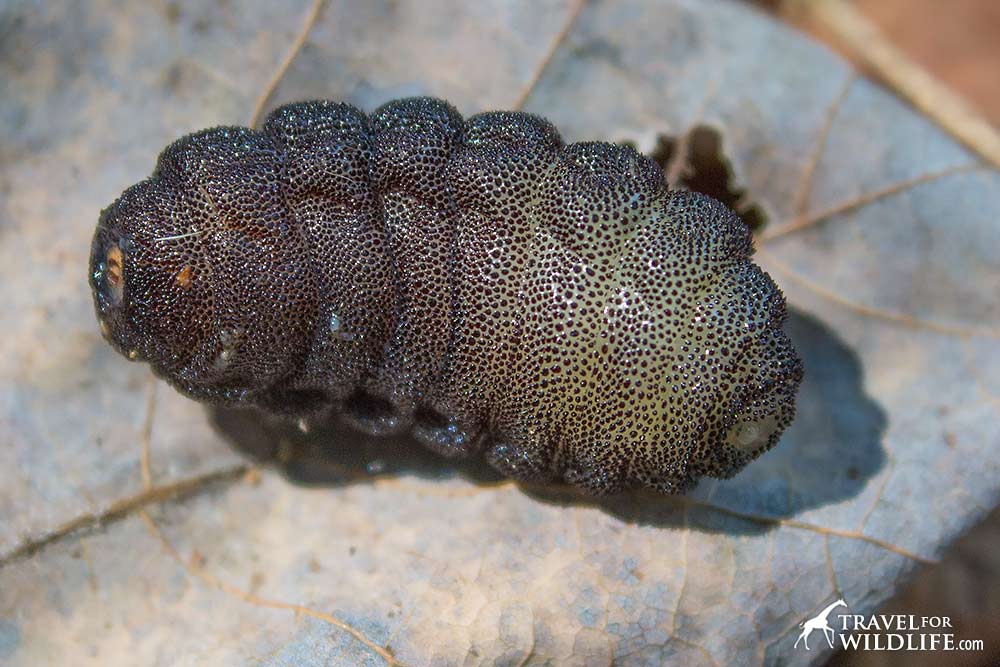
As horrid as this may all seem, the Cuterebra fly is a naturally-occurring native creature. They deserve to live just as much as the rest of us horrible people do. I made no effort to smash them with a rock, but let them make their way into the soil and carry on with their natural disgusting nauseating skin-crawling ghastly gruesome hideous little wonderful lives.
READ THIS NEXT:
Possum vs Opossum: what’s the Difference?
The White Squirrels of North Carolina
The Red Wolf, our North Carolina Endangered Wolf
Enjoy this post? Pin it!

Hal Brindley
Brindley is an American conservation biologist, wildlife photographer, filmmaker, writer, and illustrator living in Asheville, NC. He studied black-footed cats in Namibia for his master’s research, has traveled to all seven continents, and loves native plant gardening. See more of his work at Travel for Wildlife, Truly Wild, Our Wild Yard, & Naturalist Studio.

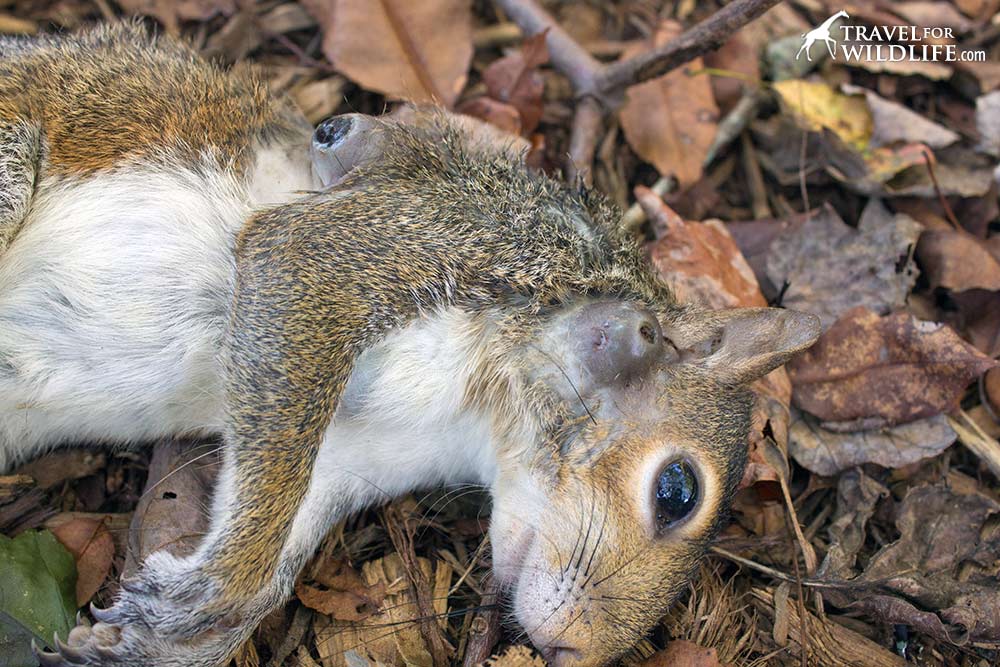
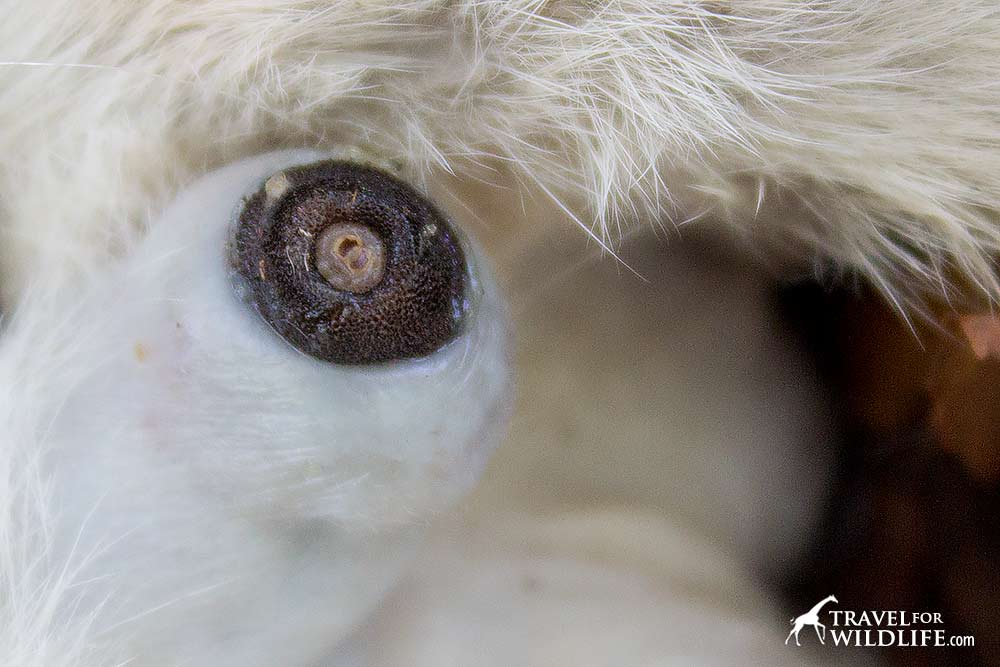
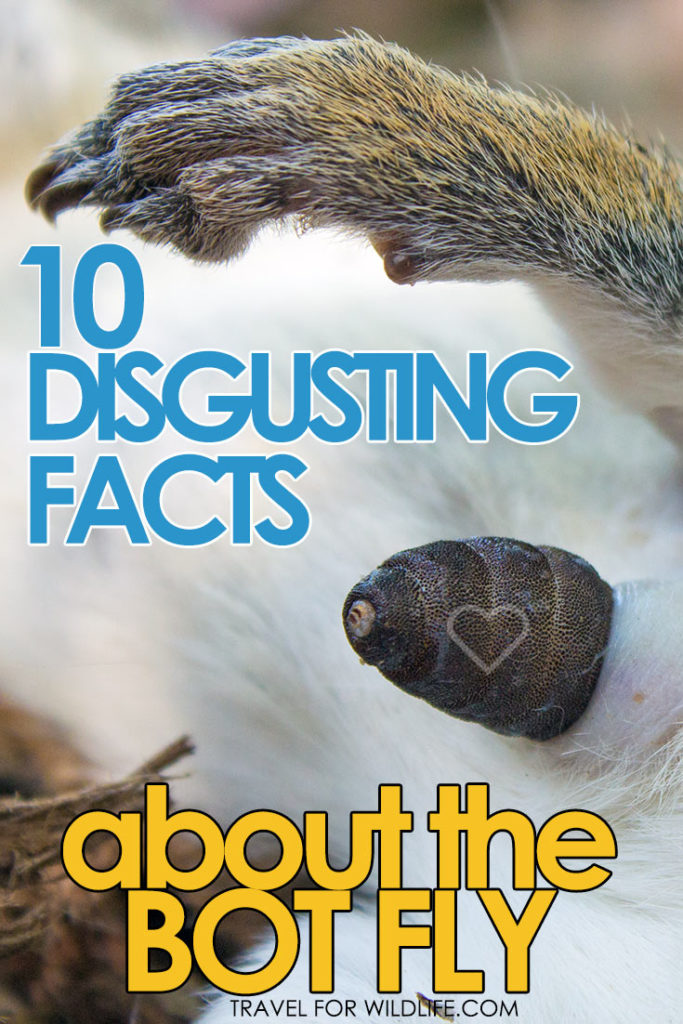
Chris Isbell
Thursday 3rd of August 2023
I recently found a couple of larva creeping around inside my house. I don't have pets so I'm wondering how these disgusting little creatures may have gotten inside my house. Can they attach to towels or other objects and be brought inside accidentally or is possible they came from a rodent that frequents my house?
cristina garcia
Monday 7th of August 2023
I believe it's possible they came in from a rodent.
Jim
Wednesday 28th of September 2022
Anecdotal experience only. Live in northern NY. Have a farm and it is necessary to kill squirrels, often several, on a daily basis. What I have noticed is that I have gone from seeing an ever so occasional botfly to seeing many squirrels with several on them over the years. Makes me wonder, is their range expanding due climate change and warming? I have noticed the same thing about ticks, as kids we never saw ticks, now they are everywhere. Good article, just wondering about range expansion.
Marsha
Saturday 27th of August 2022
Thursday August 25, 2022 my daughter and I rescued a little mouse outside of a grocery store in Ontario Canada. A lady had been kicking at it. We took the little mouse and brought it home. It looked very sick, and I thought maybe the lady had stomped on it or kicked it. It had a black protrusion right around it's anus. I thought maybe the lady did step on it and it was protruding intestines or something. We tried our best to help the little mouse, and give it comfort. And about 3 hours later it died in my hand. Well, that black protrusion started to wiggle and move and come out of it's body! My daughter and I were in horror! I knew enough to understand that this was obviously a parasite. And explained that to my daughter. I then did google searches for this larvae type creature and found out it was a bot fly larvae. EWWWW!
San
Friday 26th of August 2022
You should kill it before anymore victim fall! Parasite should be eradicate!
Bill Steel
Thursday 11th of August 2022
It will kill little kitten and small animals. If more than one infest your pet. it's a parasite, I would kill it if I saw it coming out. better dead than coming back to get your pets or worse your kids. In Central and South American, they put Vasaline or something else over the hole to keep it from breathing, then it will come out cause it can't breath.